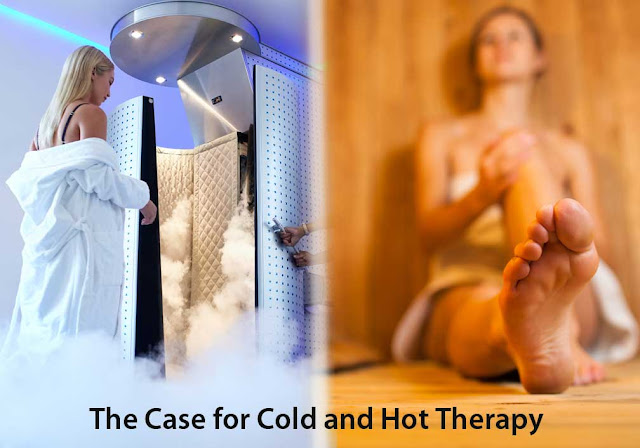The Case for Cold and Hot Therapy
I'm one of those who can't sleep if it's too hot, and at times heat has brought out that part of my personality that may err on the crankier side (the cranky race is probably tied between heat and code-red hunger). I do love summer, but I am extremely grateful for air conditioning.
I listened to a podcast about four months ago, and the interviewee was Wim Hof, aka "the Iceman." Some of his amazing feats include standing in a container filled with ice cubes for 112 minutes, climbing Mt. Kilimanjaro in shorts, and swimming 198 feet underneath the ice. Wim touts the benefits of extreme cold therapy (cryotherapy) as a tool for transformation and wellness. I started doing some more research on cryotherapy and found some interesting studies and evidence supporting its benefits.
Cold Therapy
The case for cold involves the body doing the following:
- increasing its circulation (asking the circulatory system to work harder and more efficiently)
- breathing deeper to get more oxygen into the cells
- closing the skin's pores
- increasing neurotransmitters which help with mood
- increasing metabolism
- increasing the number of mitochondria
- increasing the body's resilience to cold, and increasing brown fat
Hormesis is the process of exposing your body to a short burst of stress. In the case of exposure to cold temperatures, hormesis kicks in and many beneficial processes are activated because the body is trying to maintain homeostasis. It wants to keep your core temperature at around 98.6 degrees. One of the neurotransmitters that is generated during cold exposure is norepinephrine. During cold exposure, a cold shock protein called RBM3 is created and helps to regenerate neuronal synapses. This is very beneficial to the nervous system. Certain nutritional supplements can also activate hormesis-like effects, such as oligopolysacharides, resveratrol, and turmeric.
After my research, I decided to do a 30-day challenge of cold water therapy (my version). I intuited that ending my warm shower with 2 minutes on the coldest setting would be the right amount for me. The first time I did it, my neighbors certainly got an ear full. I stood with the cold water beating on my chest, did some spins, and put my head under the frigid water. When I got out of the shower, I felt energized with a deep sense of calm. The surrounding air felt warm and soothing. My 30-day challenge didn't end after 30 days, and I am currently up to 3 minutes of cold water shower finales (with no intention to add on more time).
Another practical way to introduce cold therapy into your daily routine is to do alternating hot and cold while showering. Put the water on at the warmest setting that you can tolerate for 30 seconds, and then turn to the coldest setting for 30 seconds. Alternate for about 5 minutes.
If you have hypothyroid and run a low temperature, cold therapy may not be the best option for you. If it doesn't feel right, then don't do it.
Hot Therapy
The most common heat therapy often comes in the form of a dry sauna. In Scandinavia, dry saunas are common in many offices and homes. Heat induces hormesis, and specifically produces new heat shock proteins which are essential for inhibiting protein degradation. Heat therapy increases the number of mitochondria in the body. These are the energy storehouses in the cell. The more mitochondria we have in the body, the better our energy levels will be and the better our bodies can function.
Another benefit of heat therapy is sweating, which helps the body to eliminate toxins like heavy metals, phthalates, chemicals, and some pathogens. Sweating also can deplete the body of essential minerals, so it is vital to make sure that you are getting proper minerals and protein before and after you sweat. Certain nutritional supplements, specifically from the companies Standard Process and Thorne Research, have great electrolyte products that keep you from losing essential nutrients.
If you are someone like me who does not like being hot, this is usually an indicator that heat therapy might not be the right fit for you. In the Ayurvedic system, people who have a lot of internal heat are called Pitta. If you know that you have a lot of Pitta, then you should limit heat therapy. In the Chinese medicine system, someone who has high liver heat should also limit heat therapy.
I had put one of my clients on a chemical and heavy metal detoxification protocol. In the middle of this protocol, she came in for an appointment and lifted her arms and showed me that her underarms were covered with a pretty severe rash. A rash like this tends to indicate that the body is pushing out toxins through the sweat glands too fast. I asked her if she was doing anything in addition to my protocol, and she mentioned that she started using the sauna every day. I told her to stop the sauna, and within days the rash went away. It is important when using saunas or doing hot yoga (which many of my clients do) to pay attention to your body. Heat therapy should be modified or ceased when necessary.
Ultimately, just because something is right for one person, it may not be the right thing for another person.
About the Author
Dr. Louis Granirer is a leading NY Chiropractor who specializes in traditional chiropractic care and holistic healing through nutrition response testing. Learn more by visiting his website at www.HolisticChiropracticCenter.com.
Additional References




Comments
Post a Comment